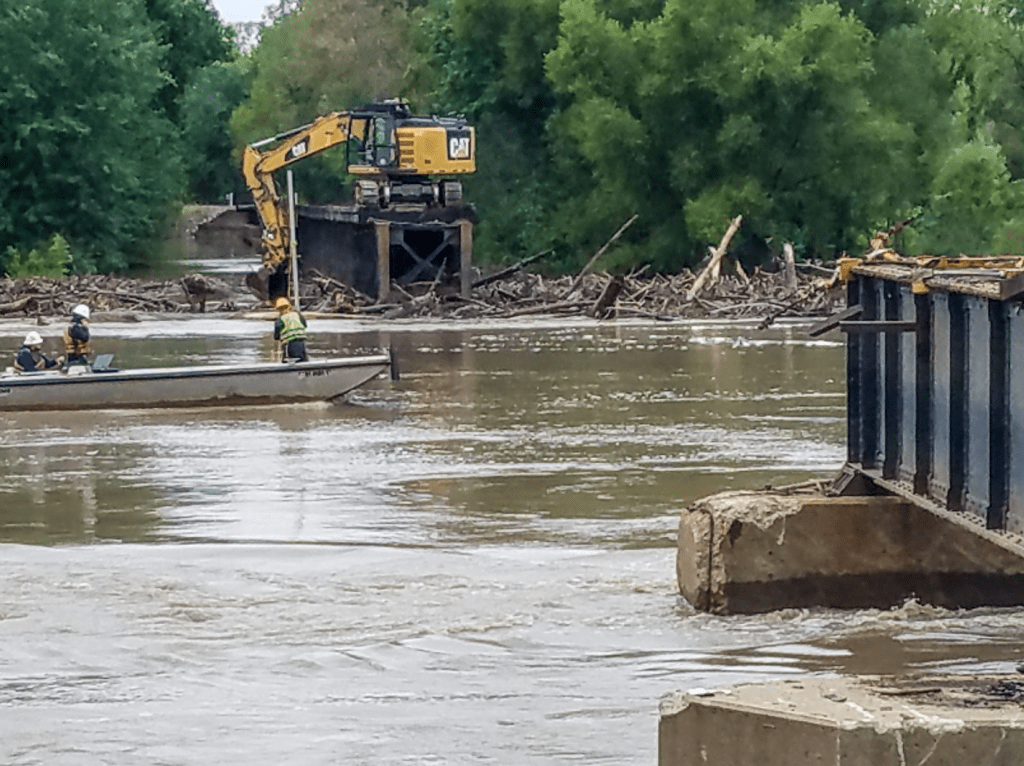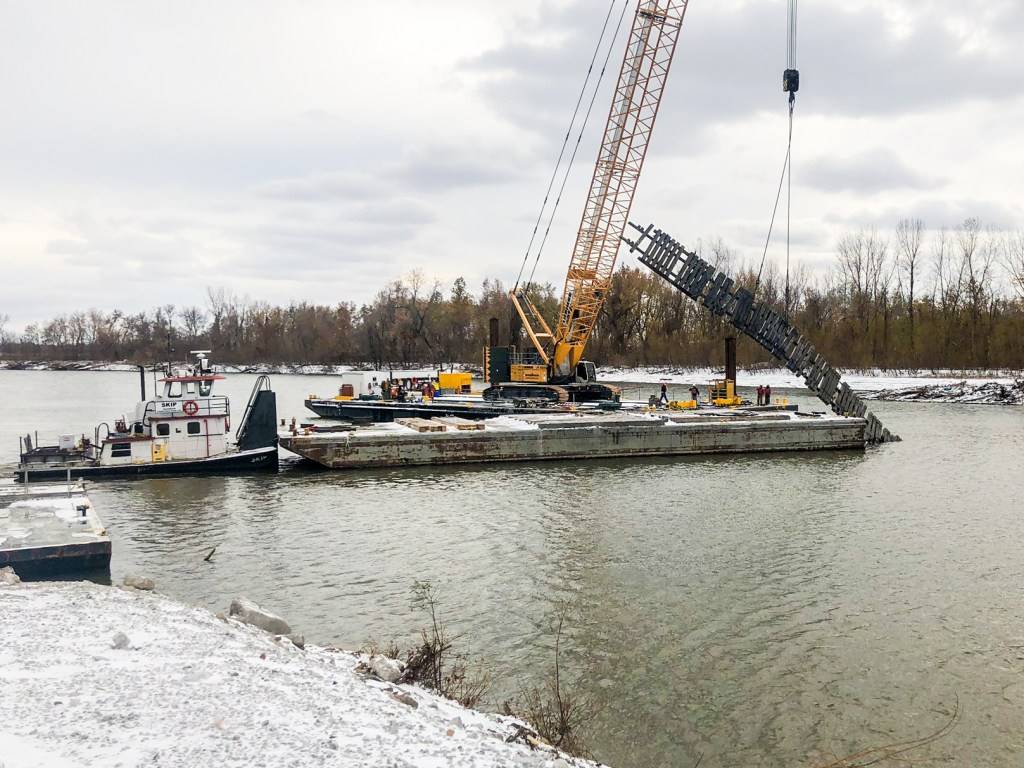Railroad turns to Hanson for design, construction management of collapsed bridge’s critical reconstruction
A dedicated team from Hanson helped Norfolk Southern Corp. rebuild a bridge in 27 days after it collapsed under the pressure of a flooded river and debris.
A buildup of tree limbs and high water had been pushing on the 103-year-old rail bridge over the Grand River near Brunswick, Missouri, leading Norfolk Southern to cut the rails the evening of Oct. 1 to relieve pressure and prevent further damage to its rail line. A portion of the bridge was wiped out within minutes. Four spans and three piers — about 267 feet of the 1,110-foot-long bridge — were swept away. (Watch a news broadcast about the collapse from Kansas City’s KCTV here.)
 Workers clean up Oct. 3, two days after part of the rail bridge over the Grand River was wiped out.
Workers clean up Oct. 3, two days after part of the rail bridge over the Grand River was wiped out.
With the bridge out, up to 14 trains per day had to be detoured, causing delays that affected the area’s economy. Grain is carried out of Chariton County on the tracks, which run through Brunswick. The bridge collapse occurred during harvesting season — another blow to farmers who had been set back by severe flooding in the spring. And the longer the bridge is closed, the risk of financial loss increases for Norfolk Southern. The railroad faced an urgent repair.
The next morning, Norfolk Southern contacted its contractor, Massman Construction Co., and Hanson for assistance. Hanson obtained hydraulic and geotechnical data from the Missouri Department of Transportation on the U.S. 24 bridge, which was a few hundred feet upstream. “This initial information proved valuable to determine an approximate elevation and material type for the local bedrock,” said Mat Fletcher, P.E., S.E., a senior project manager at Hanson’s Peoria, Illinois, office who oversaw the firm’s work for the Norfolk Southern bridge.
Meanwhile, Massman sent two barge-mounted cranes to the site of the damaged bridge to prepare for the reconstruction. Hanson’s subconsultant, Prairie Engineers, mapped what was underwater at the site by conducting what is called a bathymetric survey, which gathered as much data as possible about the location of the toppled piers and bridge debris in the riverbed. Prairie’s crew continued to provide hydrographic surveying support throughout the project.
Within a week of the collapse, Hanson had assessed the aftermath, started developing a plan for the replacement section, worked with the railroad to produce an initial layout and collected soil borings from the site to refine the estimated geotechnical parameters that were based on the U.S. 24 bridge.
 A piece of track from the bridge collapse is removed from the water Nov. 11.
A piece of track from the bridge collapse is removed from the water Nov. 11.
Deep scour was expected at this bridge. Scour — sediment that is moved away from or against bridge piers by currents, changing the flow around the piers — is a major cause of bridge failures in the U.S. Considering scour, the likelihood of future debris buildup and the collected data, two of the three replacement piers required drilled shafts socketed into the shale bedrock. The third pier, near the eastern bank of the river, would be installed with pipe piles driven deep below the riverbed. It was anticipated to take as long as two weeks to get the 6-foot-diameter drilled shafts in place. “Ultimately, it only took four days,” Mat said.
Saving time was crucial. Precast concrete was used to accelerate the construction of the piers. The design team adapted the foundation elements to be precast and used the updated field measurements to locate the connection points for erection. The precast fabricator made the final adjustments and delivered the precast by truck. The precast pier caps were made using high early strength, high-performance concrete, then steam-cured overnight, which meant these pieces could be delivered and ready to install within 24 hours after the concrete was poured. To install the caps — which each weigh 63 tons, equivalent to about 25,000 bricks — onto the piers, Hanson determined that using post-tensioning rods would save time and materials. Other bridge components were already available elsewhere, such as steel spans from Norfolk Southern’s inventory that could be transported by railcar.
“Once the caps were installed, Massman could proceed with erecting the adjacent spans with new bearings, and Norfolk Southern crews could finish installing the open deck ties and, eventually, the rail,” Mat said. After some final adjustments, the bridge reopened to trains Oct. 28.
Bridge Rebuilt
A Norfolk Southern train crosses the rebuilt bridge.
Everyone on the project was focused on quickly rebuilding the bridge to get Norfolk Southern’s track back in service. Several Hanson employees worked during the evenings and weekends, and the contractor team pulled double shifts to keep the construction going around the clock. Hanson’s preliminary design drawings were provided to all team members to review and offer input. Drew Dragoo, P.E., a Hanson railroad engineer who works with Mat in the Peoria office, was at the site to help with coordination and provide construction management services, and Hanson used a drone to photograph the project’s progress. “Everyone can say that working as a team with Norfolk Southern, Massman Construction Co. and Hayes Drilling Inc. during the accelerated construction of the replacement bridge was a rewarding experience to be a part of,” Drew said. “It was critical to be ‘hands on’ during the construction as the contractor worked around the clock. Communicating to gather everyone’s expertise in a timely manner kept the construction moving forward at an accelerated pace until the first train crossed the river.”
This post previously appeared on Hanson’s Elements blog.